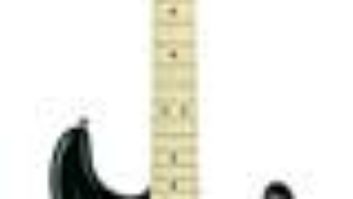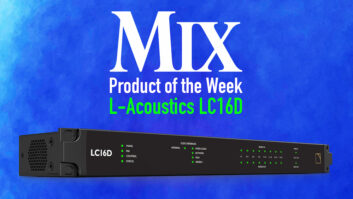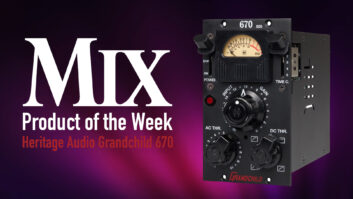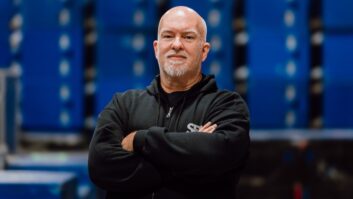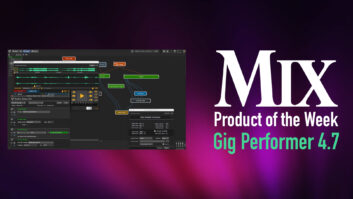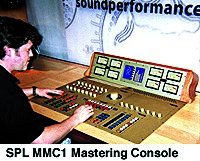
The annual Musikmesse/ProLight+Soundshow, held in Frankfurt, Germany from March13 through 17, 2002 isnothing short of gargantuan, with a dozen halls filled with the latestin musical instruments and audio gear. Given its size, Musikmesseoffers a little bit of everything, from an entire exhibition hall ofaccordions, to some very AES-looking halls devoted to high-end audiofrom distinctly non-M.I. suppliers such as Meyer Sound Labs, TridentAudio, Neumann, Nexo, DPA, Apogee Sound, Midas, Nagra, Funktion-One,Turbosound, etc.
Taking place just a few weeks after this year’s highly successfulNAMM show, there was some concern whether this year’s Musikmesse wouldoffer much in the way of new products. However, this proved not to bethe case, as the Frankfurt show had no shortage of hot debuts–both proand M.I. Here are a few highlights…
Pro Consoles!
The most talked-about product at Musikmesse was Yamaha‘s02R96, the long-awaited successor to its revolutionary 02R digitalconsole (see “Technology Spotlight” at the end of this article).
Notall consoles were digital. SPL (www.soundperformancelab.de) unveiled its MMC1, ano-compromise, fully-discrete analog console for stereo/5.1/6.1/7.1mastering. Designed with DVD-A and SACD specs in mind, and pricedaround 64k Euros (approx. $55,000 US), the MMC1 is centered around twolarge, backlit, multichannel potentiometers for adjusting playbackmonitor and master output levels. A logic-controlled patchbay (withfour memories) handles various routings/sequences of multichanneloutboard gear for insertion into the master outputs, allowing theengineer to instantly compare different combinations/orders ofprocessing (compression, EQ, harmonic enhancement, etc.). All switchinguses gas-filled relays and active processing is via SPL’s Supradiscrete 120 volt(!) opamps with 150 dB dynamic range and 34 dB ofheadroom. Eight large VU input meters and an RTW 10800 visual surroundmonitor (offering correlation, phase, surround analysis, vectorscope,RTA and 8-channel peak output metering) are standard.
Software
The biggest news insoftwareland had to be Steinberg’s debut of Cubase SX.Although it’s called Cubase, Cubase SX is an entirely new programwith a powerful new software engine, based on Nuendo technology butgeared toward music creation and production. Cubase SX featuresintelligent MIDI Input and processing tools, new virtual instrumentsand effects, graphic automation of every parameter, scoring, 5.1 mixingand unlimited undo / redo, all within a new graphic interface. Itintegrates VST System Link for combining computers for additionalprocessing power. Cubase SX will support Windows 2000/XP and Mac OSX; avariety of upgrades from Cubase VST are available. A bonus: Cubase VSTusers who upgrade to Cubase SX can use VST System Link to create anetwork with both applications.
Yamaha caused a stir with the debut of its Open Plug-InTechnology (OPT) open plug-in format for the control of MIDI devicesfrom within music software and sequencing products; it’s designedto provide seamless integration of hardware control surfaces, syntheditors and other MIDI tools via GUI-based editors for the devices. Theformat is based upon the Microsoft COM (Component Object Model)interface for compatibility with Microsoft Windows 9.x/ME/2000 and XP.A royalty-free SDK is available; Cakewalk and Sonic Foundry are some ofthe first partners. Visit www.yamahasynth.com for more details.
We got a sneak preview of SONAR 2.0, the latest version ofCakewalk’s (www.cakewalk.com) multitrack recording/editingsoftware introduced last year. This upgrade features the Cyclone DXiGroove Sampler, a software synth that lets users manipulate and combineindividual slices of Groove Clips and ACID loops. Cyclone DXi can alsoextract and re-map loop rhythms, and trigger up to 16 groove pads inreal-time with a MIDI input device, keyboard or mouse. SONAR 2.0 alsooffers ReWire 2.0 support, 64-bit DirectX 8 audio-mastering effects, amultiport graphical drum editor, a new Synth Rack for more flexibleintegration of DXi software synths, global MIDI control surface supportand support for Yamaha Open MIDI Plug-in Technology.
In addition to announcing it’s now distributing Samplitude,Emagic (www.emagic.de) showed Phat Channel, an extensionunit for the Logic Control system that offers 32 additional V-Pots,providing direct access to parameters of a track, an audio instrumentor Logic Platinum plug-ins. One cool Phat Channel feature is Splitmode, which allows different editing functions to be spread acrossdifferent displays and V-Pots, ideal for plug-in or instrumentediting.
Propellerhead Software (www.propellerheads.de) showed Reason 2.0. One ofthe coolest new features in the upgrade is the MalströmGraintable Synthesizer, which combines granular synthesis withwavetable synthesis, with a variety of filters and twomodulators/LFOs. Also new in Reason 2.0, the NN-XT AdvancedSampler, with automatic pitch detection and mapping of samples;enhanced sequencer features including Zoom, Line and Eraser tools (andthe ability to break away and resize the sequencer); The Orkester NN-XTSound Library, featuring orchestral samples ranging from singlewoodwinds to complete string sections; and of course support forWindows XP and Mac OS X (including Core Audio, Aqua GUI and anyMIDI interfaces recognized by Mac OS X).
Signal Processing
More and more plug-ins are being developed for
TC Works
’(
)PowerCore.
DSound
’s V12 Multichannel Valve Interfaceplug-in provides the warmth of classic tube interfaces in asimple-to-use software emulation. Up to eight channels are available,with a master saturation control. 24/96 is supported.
Three years ago at Frankfurt,
Korg
(
) blew usaway with its Kaoss Pad Dynamic Effect/Controller. Now Korg has takenthe concept of this brilliant XY-axis pad/signal processor one stepbeyond with the new KP-2 Kaoss Pad, which greatly expands the paletteof built-in effects and adds an onboard sampling function (up to sixseconds at 44.1 kHz for each of the two sample keys).
Highly regarded for its excellent signal processing,
TCElectronic
(
) unveiled the M300 Dual EngineProcessor, a digital reverb/multieffects unit that retails at anamazing $299 and includes 99 user presets and 256 factory settings.
Instruments
Noah, from
CreamWare
(
) generated a buzz on the showfloor. The software-controlled hardware synth offers analog(subtractive), FM, vector AND wavetable synthesis, plus new physicalmodeling technology for guitar and bass sounds. And if that’s notenough synthesis to keep you up all night, there’s an option forsampling and PCM, plus Noah features plug-in technology for even moreinstruments, and offers extensive editing and effects. The basicpackage comes with nine instruments, including Minimoog and B3emulators. Noah is available in both rackmount and keyboardversions.
On the heels of the Winter NAMM release of its Grand Piano VSTinstrument,
Steinberg
(
) introduced the Virtual Guitaristfrom Wizoo. Playable via MIDI, the Virtual Guitarist is actually twoinstruments, acoustic and electric. Included are 20 virtual playersoffering different popular guitar sounds, styles and phrasing.There’s even intelligent fret noise.
VirSyn
(
) showed TERA, a software-basedintegrated synth workstation with 16 modular synths, sequencing and amixing console with an effect rack containing up to 48 individualeffects. TERA’s multisynthesis engine offers analog synthesis,physical modeling and FM synthesis, plus VirSyn’s “spectralsynthesis,” which allows users to create dynamic resonant structurescontaining 128 resonance filters. TERA works as a standalone app or asa VST plug-in.
Emagic
‘s (
) Vintage B3 is a software instrumentfor Logic 5 that models–you guessed it–the legendary Hammond. TheEVB3 is laid out like the original, but offers an extra octave aboveand one below the five octaves of the original. The detailed simulationof the original electromechanical tone generation includes key clickand speaker simulations. Effects include vibrato, tremolo and wah; aLeslie effect plug-in is also available. Emagic also showed the EVD6, avirtual Clavinet that recreates the sound of the original HohnerD6.
Ofcourse, if you wanted a
real
Hammond, you’d have to cram intothe packed
Hammond
(
booth, where attendeeschecked out the “New B3,” a recreation of its classic B3 organ.Identical in dimensions to the original (but thankfully, half theweight!), the New B3 offers the familiar dual manuals, reverse keys,drawbars and pedals, but features digital tonewheel generation, MIDIout, Flash card memory, and controls for key click, treble/bass,overdrive and reverb. Deliveries begin late this year.
Studio Essentials
You never have enough mics, and Musikmesse brought in a fresh newcrop. Shipping now, the AT-4040 from
Audio-Technica
(
) is an affordable ($495list), true condenser that puts a large-diaphragm cardioid element intoa 4033-sized housing. Switches for low-cut filtering and -10dB pad(155dB max SPL with pad in) complete the package.
Tubemeister
DirkBrauner
(
) unveiled Phantom, his firstsolid state mic, built into the same body size as his tube Valvetmodel. This large-diaphragm cardioid condenser has a minimalist(no-pad-/no roll-off) design and a squeaky-clean self-noise of 8 dBA.Phantom pricing was not set at press time (probably around $1,100–withflight case and shockmount).
Russian mic builders
Oktava
(
) debuted the ML52, a figure-8 ribbonmodel in an elegant birdcage-style body. Retail is $799.
Danish Pro Audio
(
) kicked off its 10thanniversary with the launch of the 4041-SP, a large-diaphragm/low-noise(typically 8 dBA) omni designed to operate at standard 48 VDC phantompower. The 4041 is now available in three versions, as its removeablecapsule can attach to other bodies, offering options of a 48V or 130Vpowered solid-state preamp and a 130V tube version.
Neumann
(
) teamed up with
Sennheiser
(
) to create a new wireless systemusing the KK 105S capsule (based on Neumann’s KMS 105/140/150 handheldvocal mics) and Sennheiser’s SKM 5000 transmitter.
Quested
(
) unveiled the F5, a powerednear-field reference monitor in a hip two-tone cabinet. Designed toprovide the characteristic sound of Quested’s higher end designs, thesealed F5 cabinets house 80 watts of onboard biamplification driving amagnetically shielded 5-inch woofer and 0.8-inch soft dome tweeter,with front panel power, volume and LF/HF cut and boost controls.Quested also showed two 180-watt powered subs with a 10-inch long-throwwoofer: The F19 is intended for adding bass to existing full-rangestereo monitors. Designed for surround, the F19.1 provides LCR I/Os, adedicated LFE input with gain control and several low pass filtersettings, phase adjustment and sub out/direct input for using multiplecabinets in 6.1 or 7.1 applications.
Live Sound
Distributed in the U.S. by ATI (
),
Audient
‘s Aztec LiveConsole features a modular architecture and 32, 40, or 48 inputchannels. Features include 12 VCA sub groups, eight audio subgroups,VCA solo, a 12×8 matrix, eight mono and two stereo aux buses, and LCRoutputs. A stereo ambience input facilitates in-ear monitoring andscene automation is standard. The board’s innovative exterior framedesign protects the mixer, while providing numerous handgrip positionsfor loading the console through narrow doorways or into tightinstallation spaces. Aztec is already in use on the Groove Armada tourin the U.K.
Martin Audio
‘s (
) Wavefront W8L useshorn-loading techniques in a line array format to produce an extremelypowerful system, providing max continuous SPLs in the 134dB range. This3-way, full-range box–also useable without subs in manyapplications–combines proven driver-loading techniques withvertically-coupled waveguides and true constant directivity horns forhigh efficiency and coverage consistency. Inside is ahorn-loaded/ported 15-inch woofer, and vertically-coupled constantdirectivity horns loaded with two 8-inch cone mid drivers and three1-inch HF compression drivers.
Debuting at Winter NAMM,
JBL
‘s (
)SoundFactor line, brought JBL performance to new levels ofaffordability, with the $379 SF15 (15-inch 2-way) and $499 SF25(dual-15 2-way) FOH cabinets with 1,000-watt power handling. Now JBLrounds out the series with the SoundFactor SF22SP powered sub,featuring dual 12-inch woofers in a bandpass enclosure and an onboard500-watt peak (300W continuous) power amp. The 32x18x35-inch SF22SPcabinet weighs 126 pounds; removeable 3-inch casters simplify loadin/out.
More to Come!
There were plenty of other interesting debuts at FrankfurtMusikmesse and we’ll include some of these in our regular new productsections in the months to come. Meanwhile it’s not too early to startplanning for next year’s show, held March 5 to 9, 2003. For moreinformation, visit
.
TECHNOLOGY SPOTLIGHT:
YAMAHA 02R96
In 1995, Yamaha kicked off anot-so-quiet revolution with its original 02R, a 20-bit/48kHz digitalconsole with moving faders, instantaneous reset of all consoleparameters; dynamics on every channel; two internal effects processors;and 24 analog inputs and 16 digital tape returns for a total of 40inputs. Its feature set was not so radical–certainly, other digitalconsoles offered more, but it was the 02R’s under-$10,000 price tag(about 50-times less than competing products!) changed the audioindustry almost overnight. Now for about 10% more than the original02R, Yamaha unveils its next generation–the 02R96.
It would have been fairly straightforward for Yamaha to simplyupdate the existing 02R for 24/96 production. However, the new 02R96updates every aspect of the console, with more than five times theprocessing power of the original 02R. Many of the 02R96’s key featuresare shared with Yamaha’s recently-announced DM2000 (profiled in theJanuary 2002
Mix
)–such as 24-bit/96kHz audio, improved high-resmic preamps, Sony 9-pin (P2) and MMC control, surround monitoring andDAW integration, while it retains the same sized footprint as theoriginal 02R. The control surface and user interface were enhanced fora more analog-style, hands-on operation, and 16 assignable user-definedkeys speed production tasks. The 02R96 offers 56 input channels andadds a direct out function for routing the signal from any channeldirectly to any digital or analog output.
Surround features include 5.1 panning, multichannel monitoring andbass management. The assignable joystick control has smooth 128x128resolution and a divergence parameter can adjust the hard/phantomcenter ratio for each channel. Also standard is 32-bit internalprocessing and a comprehensive range of 96kHz-compatible stereo effectsplus several designed specifically for surround.
The console’s 24 100mm motorized channel faders can beinstantaneously layer-switched to control any of its 56 input channelsor integrate with directly with DAWs such as Digidesign Pro Tools,Steinberg Nuendo and Emagic Logic Audio. The 02R96 ships with Yamaha’sStudio Manager software, for external Mac or PC control and managementof all console parameters.
Customization options are numerous, from the comprehensive meterbridge to the wide range of new 24-bit/96kHz-capable Mini-YGDAI I/Ocards for ADAT, TDIF, AES/EBU, mLAN and analog interfacing. The 02R96is also compatible with third-party cards from Waves and Apogee.However, the coolest option of all is using the built-in cascade portsto link a second 02R96 for 112-channel operation.
The 02R96 is set for June, 2002 deliveries. For more information,visit
.
–GeorgePetersen
